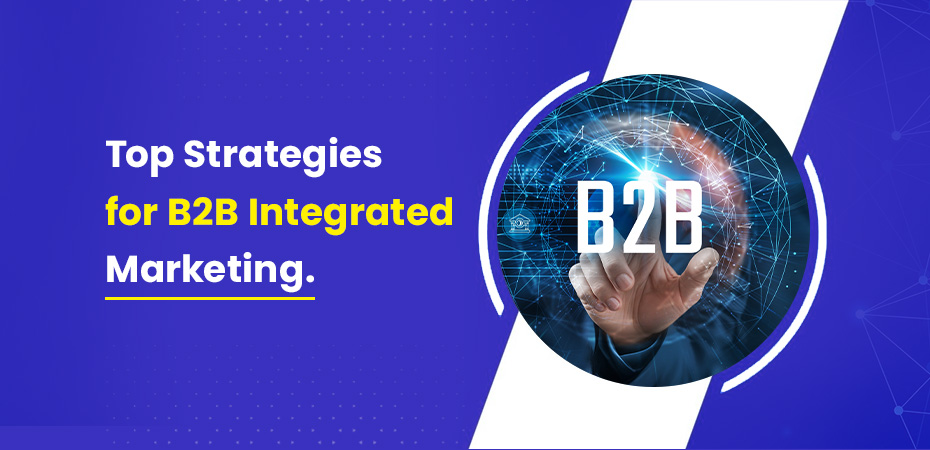Top Strategies for B2B Integrated Marketing



Introduction
In today’s competitive online world, B2B companies can’t afford to use scattered marketing efforts. A well-planned marketing strategy helps all channels work together smoothly to attract leads, build brand awareness, and increase sales.
B2B businesses face unique challenges, such as long sales cycles, multiple decision-makers, and complex buying processes. To handle these challenges, a smart marketing approach that uses multiple channels and data is essential. Whether it’s SEO services in Phoenix, content marketing, email campaigns, or social media, all marketing efforts should work together toward the same business goal.
In this guide, we’ll share simple and effective integrated marketing approaches to help your business grow through B2B integrated marketing.
B2B Integrated Marketing- Definition and Importance
What is B2B Integrated Marketing?
B2B integrated marketing is a strategy that combines multiple marketing channels—such as SEO, content marketing, social media, PPC, and email marketing—to create a unified brand message. Instead of handling each channel separately, integrated marketing ensures they work together smoothly. This approach helps businesses engage potential clients more effectively and increase lead conversions by delivering a consistent experience across all touchpoints.
B2B vs. B2C Integrated Marketing
B2B and B2C integrated marketing serve different audiences and follow distinct approaches. B2B marketing targets businesses, meaning it focuses on logic, value, and relationship-building. Buyers in B2B settings often need detailed information, personalized communication, and time to evaluate options before making a purchase. Since multiple decision-makers are involved, B2B marketing requires educational content, industry insights, and long-term nurturing strategies.
On the other hand, B2C marketing targets individual consumers, making it more emotional and impulse-driven. The goal is to grab attention quickly, create an emotional connection, and drive fast purchases. B2C strategies often use storytelling, visuals, and discounts to encourage immediate action.
Here’s a comparison of the two approaches:
Feature B2B Integrated Marketing B2C Integrated Marketing Target Audience Businesses and professionals Individual consumers Decision Process Long, involves multiple people Quick, often impulsive Content Type Educational, detailed, data-driven Short, engaging, emotional Marketing Channels SEO, content marketing, email, LinkedIn Social media, ads, influencers Sales Cycle Long, requires nurturing Short, immediate purchases Emotional Appeal Low, focused on value & ROI High, focused on emotions
Why Is Integrated Marketing Important for B2B Brand Campaigns?
Creates a consistent brand message across multiple channels.
When all marketing channels share the same message, it helps businesses build trust and recognition. Customers see the same branding, values, and information whether they visit a website, social media, or read an email.
Enhances customer experience by providing seamless interactions.
When marketing efforts are connected, customers can move smoothly from one channel to another without confusion. Whether they read a blog, watch a video, or talk to a sales team, they get a clear and helpful experience.
Maximizes Return on Investment (ROI) by integrating paid, organic, and direct marketing efforts.
A well-planned marketing strategy ensures that every dollar spent is used effectively. By combining different marketing types, businesses reach more people while reducing wasted efforts.
Aligns sales and marketing teams for better lead conversion.
When marketing and sales teams work together, they can turn more leads into customers. Shared goals and data help both teams understand what potential buyers need.
Uses data-driven insights to optimize marketing efforts.
Businesses can track customer behavior, analyze data, and improve their marketing strategies. This helps them focus on what works best and adjust their efforts for better results.
Core Strategies for B2B Integrated Marketing
1. Aligning Sales and Marketing Teams
When sales and marketing teams work together, businesses get better results. Marketing brings in good leads, and sales turn them into customers. Proper alignment helps both teams succeed.
How to align sales and marketing?
- Use CRM software: A Customer Relationship Management (CRM) system helps track leads and customer interactions. This keeps both teams updated and organized.
- Develop shared goals: Set common Key Performance Indicators (KPIs) so sales and marketing teams focus on the same objectives. This improves teamwork.
- Hold regular meetings: Frequent meetings help both teams discuss strategies, share insights, and solve problems together.
By working as one team, sales and marketing can boost revenue and customer satisfaction.
2. Data-Driven Decision Making
Data helps businesses make better marketing decisions. By analyzing data, companies can understand customer behavior and improve their strategies.
Key tools for data-driven marketing:
- Google Analytics: Tracks website visitors, showing how they interact with your site.
- CRM software (HubSpot, Salesforce): Helps manage customer data, making it easier to follow up on leads.
- Marketing automation tools (Marketo, Mailchimp): Automate email and PPC campaigns to reach the right audience at the right time.
Using data-driven tools helps businesses create smarter (B to B) marketing plans and achieve better results.
3. SEO and Content Marketing Integration
SEO is essential for B2B marketing as it helps businesses rank higher on search engines and attract potential customers. A strong SEO strategy increases visibility and credibility.
How SEO improves B2B marketing:
- Ranks for industry keywords: Helps businesses appear in searches for terms like Phoenix SEO services.
- Brings high-intent traffic: Attracts visitors actively looking for solutions.
- Builds brand authority: Thought leadership content makes businesses more trustworthy.
Best SEO and content marketing practices:
- Do keyword research: Find the right terms your audience searches for.
- Create valuable content: Publish long-form blogs and whitepapers to educate potential clients.
- Optimize for mobile and voice search: Ensure your site is mobile-friendly and voice-search optimized.
By combining SEO and content marketing, businesses can reach more customers and generate better leads.
4. Email Marketing and Automation
Email marketing is still one of the best ways to nurture B2B leads. It helps businesses stay connected with potential customers and guide them through the buying process.
Best practices for email marketing (B2B):
- Segment your email list: Group contacts based on their interests and needs. This makes emails more relevant.
- Use automated email sequences: Send follow-up emails automatically to keep leads engaged.
- Personalize emails: Add the recipient’s name and offer content that matches their needs. This increases response rates.
With the right strategy, email marketing can improve customer relationships and increase conversions.
5. Social Media Strategies for B2B
Social media is a great tool for B2B market planning, but it works best on platforms like LinkedIn, Twitter, and YouTube. These marketing platforms help companies connect with industry professionals and decision-makers.
How to use social media effectively?
- Post on LinkedIn: Share industry insights, case studies, and success stories to build trust.
- Engage on Twitter: Join discussions, post thought leadership content, and connect with potential clients.
- Host webinars and Q&A sessions: Use YouTube and LinkedIn Live to educate your audience and answer questions.
By using social media platforms the right way, B2B businesses can boost brand awareness, generate leads, and build strong industry relationships post.
6. PPC and Retargeting Ads
Pay-per-click (PPC) B2B advertising campaigns helps businesses get quick leads, while retargeting ads bring back visitors who didn’t convert the first time. Together, they improve lead generation and sales.
PPV strategies for best B2B Ad campaigns:
- Target high-intent keywords: Focus on search terms like SEO Expert services in Phoenix to attract serious buyers.
- Use LinkedIn Ads: LinkedIn allows businesses to reach decision-makers directly.
- Run retargeting (B2B) campaigns: Show ads to people who visited your website but didn’t take action. This keeps your brand in their mind.
With PPC and retargeting, businesses can reach the right audience and boost conversions.
7. Account-Based Marketing (ABM)
Account-Based Marketing (ABM) targets specific high-value accounts instead of marketing to a broad audience. This approach helps businesses close bigger deals with personalized strategies.
How to implement ABM?
- Identify key accounts: Use data analytics to find the most valuable potential clients.
- Create personalized (Business to Business) marketing campaigns: Tailor marketing messages based on each account’s needs.
- Use multi-touchpoint engagement: Combine emails, LinkedIn outreach, and PPC ads to stay connected.
ABM helps businesses build strong relationships with key clients and drive higher revenue.
8. Leveraging Influencer and Partnership Marketing
B2B influencer marketing means working with industry experts who can promote your brand. These experts have a strong following and can help you gain trust and visibility.
Ways to leverage influencer partnerships:
- Partner with thought leaders: Invite industry experts to write guest blogs or join podcasts. This increases your brand’s credibility.
- Work with industry publications: Get backlinks and mentions in well-known blogs and magazines to improve brand awareness and SEO.
- Host joint webinars and case studies: Collaborate with influencers on webinars or case studies to share insights and attract more leads.
Influencer marketing helps businesses reach the right audience and build strong industry connections.
9. Events, Webinars, and Offline Strategies
Attending events and networking are still important for B2B businesses. A mix of online and offline strategies can help attract new leads and strengthen relationships.
How to integrate online and offline efforts?
- Use webinars for lead generation: Webinars are a great way to educate potential customers and collect their contact details.
- Repurpose event content: Turn event highlights into blog posts, videos, or social media updates to reach a wider audience.
- Follow up with leads: After an event, send follow-up emails and use retargeting ads to keep potential customers engaged.
By combining online and offline marketing, businesses can maximize their reach and improve their success.
10. Measuring and Optimizing Integrated Campaign Performance
To succeed in marketing, businesses must track their results and improve their strategies. Measuring B2B integrated marketing campaigns’ (IMC) performance helps identify what works and what needs fixing.
Key metrics to track:
- Website traffic and SEO rankings: Check how many people visit your site and how well it ranks on search engines.
- Lead conversion rates: Measure how many visitors turn into leads or customers.
- Engagement on social media and emails: Track likes, shares, comments, and email open rates to see if people are interested in your content.
- Customer Lifetime Value (CLV): Find out how much revenue a customer brings over time.
By tracking these metrics, businesses can adjust their marketing efforts and get better results.
Conclusion
Integrated marketing is crucial for B2B companies that want to build a strong brand and generate high-quality leads. When businesses align their sales and marketing teams, use data-driven strategies, and combine different marketing methods like SEO, PPC, email, and content marketing, they create a seamless and effective approach. This ensures consistent messaging across all channels, leading to better customer engagement and higher conversions.
A well-planned B2B marketing campaign idea helps businesses stay ahead of competitors, improve customer trust, and maximize return on investment. However, achieving success requires expertise and the right B2B digital marketing plan.
For businesses looking to boost their online presence and improve SEO performance, professional guidance is essential. Partnering with experts ensures that your marketing efforts are optimized for the best results. If you need specialized support, consider exploring Phoenix SEO Ninja to enhance your digital strategy and drive real business growth and ROI.
Frequently Asked Questions (FAQs)
The best B2B marketing strategy combines SEO, content marketing, PPC, social media, and ABM, ensuring a well-rounded and integrated approach.
SEO improves search visibility, drives organic traffic, and enhances brand credibility, making it a crucial part of B2B integrated marketing tactics.
Content marketing establishes thought leadership, nurtures leads, and helps businesses educate and engage their target audience.
ABM focuses on specific high-value accounts, while traditional marketing targets a broad customer base.
Data-driven marketing helps businesses optimize B2B marketing campaigns, improve personalization, and measure performance for better results.